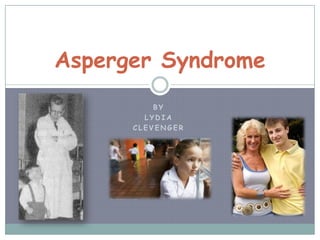
Asperger Syndrome: Characteristics and Strategies
- 1. By Lydia Clevenger Asperger Syndrome
- 2. A qualitative impairment in social interaction: Failure to develop friendships appropriate to the child’s developmental level Impaired use of non-verbal behavior Lack of social and emotional reciprocity and empathy Impaired ability to identify social cues and conventions A qualitative impairment in subtle communication skills Fluent speech but difficulties with conversation skills Tendency to be pedantic (overly concerned with details), have an unusual prosody (stress & intonation in speech), make literal interpretation Restrictive interests Development of special interests that is unusual in intensity and focus Preference for routine and consistency http://www.aspergersyndrome.org/Articles/What-is-Asperger-Syndrome-.aspx AspergerSyndrome: History and Characteristics -Hans Asperger first described Asperger’s Syndrome in 1944. -AspergerSyndrome was added to the fourth edition of Diagnostic and Statistical Manual of Mental Disorders (DSM-IV) in 1994.
- 3. Asperger Syndrome: DSM-IV Description Qualitative impairment in social interaction Marked impairment in the use of multiple nonverbal behaviors Eye-to-eye gaze Facial expression Body posture Gestures to regulate social interaction Failure to develop peer relationship appropriate to developmental level Lack of spontaneous seeking to share enjoyment, interest or achievements with other people Lack of social or emotional reciprocity http://www.autreat.com/dsm4-aspergers.html
- 4. Asperger Syndrome: DSM-IV Description Restricted repetitive and stereotyped patterns of behavior, interests and activities, as manifested by at least one of the following: Encompassing preoccupation with one or more stereotyped and restricted patterns of interest that is abnormal either in intensity or focus Apparently inflexible adherence to specific, nonfunctional routines or rituals Stereotyped and repetitive motor mannerisms (e.g. hand or finger flapping or twisting, or complex whole-body movements) Persistent preoccupation with parts of objects http://www.autreat.com/dsm4-aspergers.html
- 5. Asperger Syndrome: DSM-IV Description The disturbances causes clinically significant impairments in social, occupational, or other important areas of functioning There is no clinically significant delay in language (single words used by age 2, phrases by age 3) http://www.autreat.com/dsm4-aspergers.html
- 6. Asperger Syndrome: DSM-IV Description There is no clinically significant delay in cognitive development or in the development of age-appropriate self help skills, adaptive behavior and curiosity about the environment in childhood Criteria are not met for another specific Pervasive Developmental Disorder or Schizophrenia http://www.autreat.com/dsm4-aspergers.html
- 7. AspergerSyndrome Asperger Syndrome (AS) is classified with other Pervasive Developmental Disorders (PDD). PDD characterized by abnormalities: in socialization skills in use of language for communication in behavior Groupings under PDD vary in severity of deficits AS is characterized by higher cognitive abilities and is the mildest and highest functioning PDD group (Nielsen, 2009)
- 8. Asperger Syndrome: a form of autism? Research does not make it clear if AS is a milder form of autism or only linked to it based on similarities. Impairments between autism and AS are similar, but the degree and ability of the child differ. AS compared to Autism: Higher verbal IQ than performance More normal language ability Onset later than autism Less severe deficits in communication and social skills (Nielsen, 2009)
- 9. Communication Skills Environment Allow longer time for student to process a question Avoid rephrasing or interrupting Avoid correcting speech Model correct format instead Be concise, concrete, and specific Avoid vague terms (Nielsen, 2009) Establish a well-structured environment Provide advance notice if there will be changes to seating arrangements, the routine, or if there will be a substitute. Seating chart utilized Class schedule posted Give an individual copy to the student Classroom rules posted Avoid generalities Adjust accordingly to meet the needs of the student with AS. (Nielsen, 2009) Strategies for Educators
- 10. Socialization Assignments Select a buddy Discuss with the buddy the social needs of the student with AS Peer buddy able to promote acceptance of the student and encourage other friendships Use student with AS as a teacher’s aide Use cooperative learning situations to highlight strengths Way to foster respect among peers (Nielsen, 2009) Present visually & orally Use gestures, modeling, and demonstrate the concept Provide copies of teacher’s notes/record the lecture Allows for reviewing of the material as needed Permit use of headphones/earplugs Eliminates distracting background noise Provide alternatives Extra credit Laptops (with handwriting difficulties) Tape recorder (instead of written examination) (Nielsen, 2009) Strategies for Educators
- 11. My nephew Wesley……making excellent progress in dealing with Asperger Syndrome! People with Asperger Syndrome are often viewed as eccentric, odd, or just a little different. Early diagnosis and effective treatment enable children to deal well with disabilities . Support and encouragement from family and friends are still essential to live well.
- 12. References Nielsen, L. (2009). Asperger Syndrome. Brief reference of student disabilities…With Strategies for the Classroom. Thousand Oaks, CA: Corwin Press. Shelley, S. (2010). Diagnostic Criteria for 299.80 Asperger’s Disorder. Retrieved from http://www.autreat.com/dsm4-aspergers.html Attwood, T. (2005). What is Asperger Syndrome?. Retrieved from http://www.aspergersyndrome.org/Articles/What-is-Asperger-Syndrome-.aspx